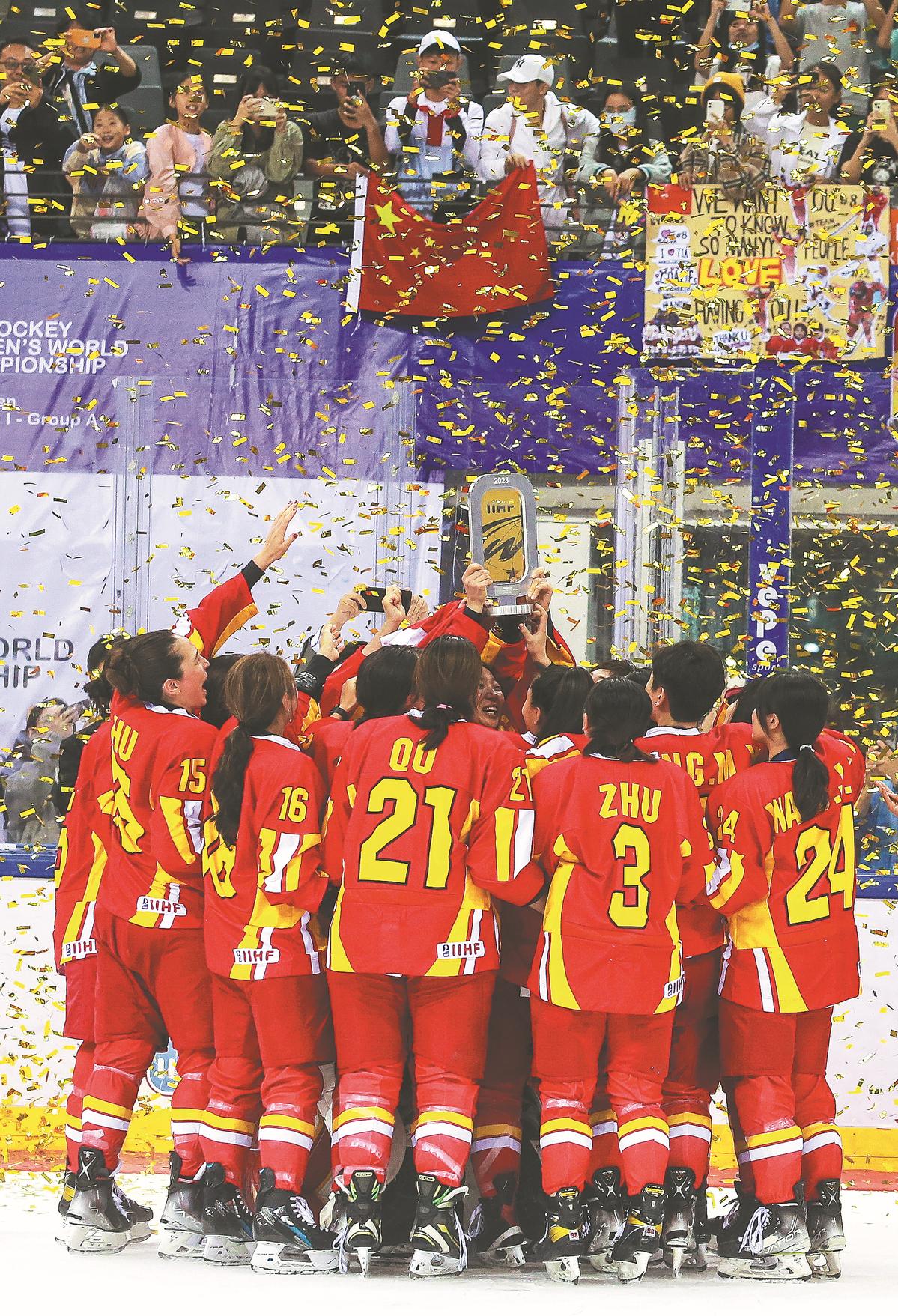Pucksters back in the big time
 0 Comment(s)
0 Comment(s) Print
Print E-mail China Daily, August 28, 2023
E-mail China Daily, August 28, 2023

Team China players celebrate with the trophy after winning the IIHF Division I Group A World Championship tournament in Shenzhen, Guangdong province. [Photo/Xinhua]
Some tears, a lot of sweat and a deep sense of pride. It's been 14 years in the making, but the Chinese women's ice hockey team is finally back in the big league after securing a long-awaited return to the world championship's top division.
And they did so in some style, dominating last week's IIHF Division I Group A World Championship in Shenzhen, Guangdong province with a perfect 5-0 record to earn promotion to the top flight next year.
The winning streak on home ice at the second-tier I-A tournament ended the team's absence from the top echelon after its last appearance there in 2009.
Captain Yu Baiwei is the only player in the current squad that remains from that 2009 side, and she couldn't hold back the tears after her unwavering efforts over a decade paid off.
"It's been so long and so tough that I had almost given up hope of getting back again. I am so happy that I didn't lose faith and we did it. I am over the moon now," Yu, a 35-year-old defender, said in an emotional postgame interview after Team China beat Austria 2-0 on Thursday to secure promotion with a match to spare.
"I really appreciate our whole team's efforts as one. I want to thank my teammates for helping me make it all worthwhile after spending so many tough years struggling and trying hard.
"It paves the way for us to go for qualification for the 2026 Winter Olympics and we won't stop here for sure," added Yu, who made her national team debut in 2005 at 17.
The I-A championship in Shenzhen involved four other teams — the group's highest-ranked Denmark (11th), Norway, world No 15 Slovakia and the Netherlands.
Team China, who just climbed up from the third-tier I-B tournament last year, opened with a 1-0 victory over Slovakia on Aug 20. Then came an inspirational 5-3 comeback win against Norway before a stunning 4-2 triumph against championship favorite Denmark on Wednesday in what was arguably the highlight of China's campaign.
A 2-1 victory over the Dutch in the final match on Saturday kept the host unbeaten on home ice, while the Danes clinched the second promotion spot with a 4-1 rout of Norway to finish runner-up in Shenzhen.
"I am extremely proud of this whole group. It took everybody to pull this off," said Team China forward Lin Qiqi, known as Leah Lum in her native Canada.
"We fought hard this entire time. We've been here for so long and we deserve to be back in the main group," added Lin, who scored the vital first goal for Team China late in the second period against Austria.
The Chinese and Danes will be up against the world's heavyweights, such as Canada, the United States and Finland, at the 10-team top division tourney at Utica, New York in April next year.
For captain Yu, the return will also allow her to renew rivalries with some of her old foes — legendary Canadian forward Marie-Philip Poulin and her teammate Rebecca Johnston, and Sweden's long-serving goaltender Sara Grahn — the only three pucksters from the rest of the world still playing who competed in 2009 with Yu.
Now set to rejoin those hardy veterans, Yu said the promotion has given her extra motivation to continue her career.
"I am not done yet. As long as I am playing, I will try to deliver my best performances on the ice," she said.
Long and winding road
As one of the first Asian countries to develop women's hockey, China had enjoyed consistent success in the 1990s, highlighted by three fourth-place finishes at the 1994 and 1997 top-tier worlds, as well as at the 1998 Winter Olympics in Nagano, Japan.
The shrinking talent pool in the State-run sports system and a lack of facilities, however, began to take a toll on the women's national program, resulting in a slump on the international stage beginning in the late 2000s.
To improve in time for the home Winter Olympics, China's winter sports governing body, supported by professional club Kunlun Red Star, approved a naturalization policy in 2017 to incorporate North American-born players with Chinese heritage into the national program, eventually building two teams — on both the men's and women's sides — heavily reliant on overseas reinforcements for Beijing 2022.
Seven out of the total 22 players on Team China's roster in Shenzhen were born in Canada or the United States and developed their early careers in the North American system, including Lin and star goaltender Chen Tiya.
After doing the country proud with a brave fight to finish ninth at the home Olympics last year, Team China's back-to-back promotions have drawn increasing attention to the sport, which is gaining popularity at the junior level in major cities. Ice hockey is even flourishing in warmer southern cities such as Shenzhen, which was once considered a wilderness in terms of winter sports.
The city's commitment to developing facilities and promoting the sport landed it the rights to host the I-A worlds for three editions in a row, from 2023-25.
"We had a long discussion with the high sport authorities (in China), and they really want to continue and push further the development of ice hockey. It's really good for women's hockey globally," Luc Tardif, IIHF president, said during the Shenzhen tournament.
"When the Chinese people jump in the sport, they don't go halfway. We want to be by their side to participate in this development."






Go to Forum >>0 Comment(s)